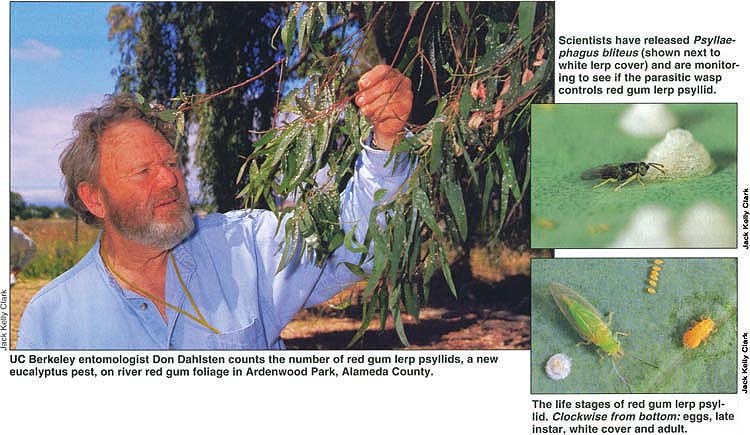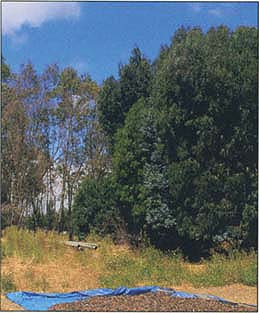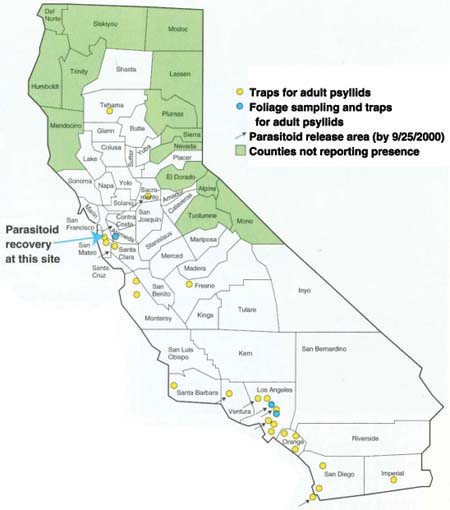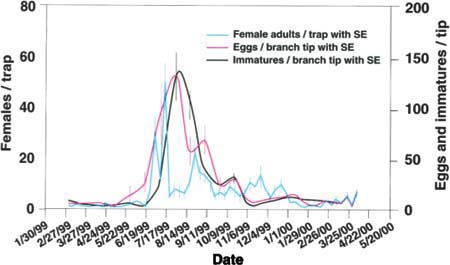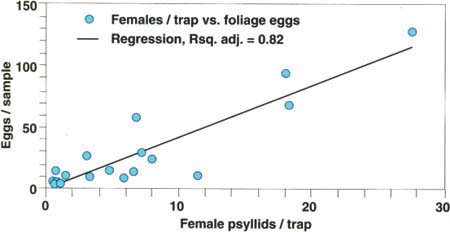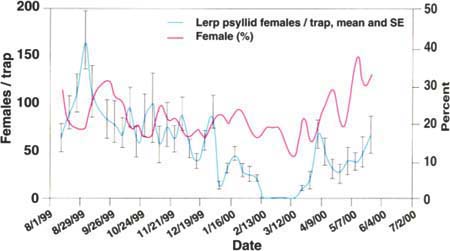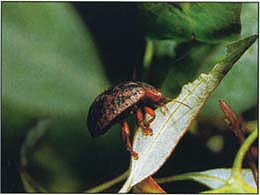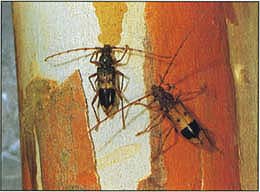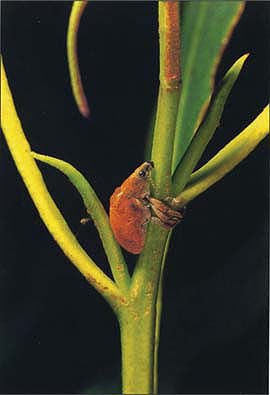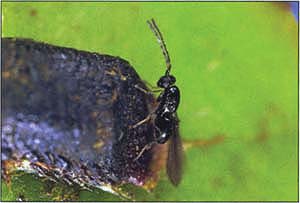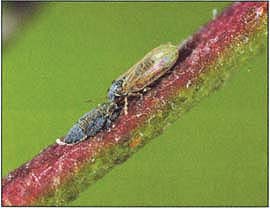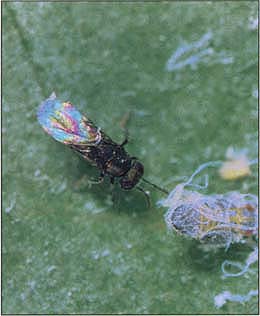All Issues
UC scientists apply IPM techniques to new eucalyptus pests
Publication Information
California Agriculture 54(6):8-13. https://doi.org/10.3733/ca.v054n06p8
Published November 01, 2000
PDF | Citation | Permissions
Abstract
Eucalyptus trees have been important components of the California urban landscape for almost 150 years. Until 1984, they were free of both insect and disease pests. In the last 16 years, however, a series of herbivorous insect species have been introduced into the state, probably accidentally, causing significant damage to the trees. Research programs have provided solutions to some of these pest problems, but more pests are continually introduced, recently the red gum lerp psyllid, the lemon gum lerp psyllid, and the eucalyptus tortoise beetle. Scientists are developing new strategies to control the recent invaders in concert with existing pest management programs, integrating methods across broad geographic, horticultural and economic scales.
Full text
Left, UC Berkeley entomologist Dan Dahlsten counts the number of red gum lerp psyllids, a new eucalyptus pest, on red river gum foliage in Ardenwood Park, Alameda County. Top right, Scientists have released Psyllaephagus bliteus (shown next to white lerp cover) and are monitoring to see if the parasitic wasp controls red gum psyllid. Bottom right, The life stages of red gum lerp psyllid.Clockwise from bottom: eggs, late instar, white cover and adult.
Visitors to California are struck by the abundance and variety of eucalyptus trees throughout the state. More than 700 species in the genus Eucalyptus are native to Australia and New Guinea, and approximately 90 species have been introduced into North America over the last 150 years (Doughty 2000). Some species have not been viewed favorably because of their messy growth habits, and in fact one species (E. globulus) has been listed as a potentially invasive weed. However, many other species have great value for their form, evergreen foliage, floral show and other horticultural qualities.
Eucalyptus trees are now found throughout the state in areas with suitable climates. The trees are capable of very rapid growth and can thrive without supplemental irrigation in many sites. Consequently they have been widely planted for a variety of purposes. It has been reported that early introductions were made to provide timber for railroad ties and milled lumber. Unfortunately, either the species planted were not appropriate or the growing conditions were unsuitable for supporting these early commercial ventures. Recently, however, there has been a renewed interest in planting eucalyptus as an economical source of biomass, hardwood veneer and very high quality cellulose pulp for the production of printer and photocopier paper. As the resource value of native forests in California is reassessed in terms that limit timber harvest, renewable plantations of trees like eucalyptus may become increasingly important to meet the expanding demand for wood fiber.
Eucalyptus trees have been used extensively in windbreak plantings in many agricultural areas statewide.
However, the most valuable use of the trees has been their widespread planting in California urban landscapes.
The trees provide aesthetic value, absorb sound and pollutants, and offer shade, reducing the heat load on structures and decreasing cooling costs.
Low water requirements and, until recently, the absence of insect pests and diseases, have made eucalyptus a particularly important component of the urban forest.
Eucalyptus trees were first brought into the state around 1850 as seeds (Doughty 2000), ensuring that potential pest insect species were not introduced with the trees. More than a century of relatively pest-free status changed with the discovery of the eucalyptus longhorned borer, Phora-cantha semipunctata, in Orange Coanty in 1984. Since that time, about 15 different eucalyptus-feeding insect species have been introduced into California, putting the tree resource at risk. While all of these insects are native to Australia, about half of them exist in other parts of the world, making it difficult to determine their source population and mode of entry into California.
Introductions of pest species of eucalyptus have continued with unfortunate regularity over the last two decades. Three recent arrivals have triggered new research efforts, the most comprehensive to date aimed at managing the red gum lerp psyllid and eucalyptus tortoise beetle. New exotic pests are continually introduced into the California landscape, requiring new control efforts. Scientists must apply integrated pest management (IPM) techniques to manage the new eucalyptus invaders in the context of the existing suite of pests.
New IPM challenges
Since the detection of the first introduced pest of eucalyptus in 1985, the rate of discovery of a new eucalyptus-feeding insect has approached one per year. On Aug. 14, 2000, the latest eucalyptus pest to enter California from Australia was discovered on lemon gum eucalyptus near the Los Angeles airport. The lemon gum lerp psyllid, Eucalytolyma maideni, has spread quickly to adjacent counties, and research will be initiated in the near future to find a solution to this new problem.
The research programs supported by the UC IPM project have quickly provided solutions to many serious pest problems. However, the continuing introduction of new insect pests potentially jeopardizes the balances achieved in these successful IPM programs. Management solutions for red gum lerp psyllid, tortoise beetle and a long-horned borer are under investigation.
Glycaspsis brimblecombei.
The red gum lerp psyllid, Glycaspsis brimblecombei, was first detected on June 17, 1998, in El Monte, Los Angeles County, and infestations were observed in other Southern California locations and in Northern California by July of that year. Like the blue gum psyllid that was introduced earlier, this psyllid feeds on plant fluids that it extracts from young leaves. Although this insect feeds on a broad range of Eucalyptus species, it prefers to colonize members of the red gum species group, particularly river red gum (E. camaldulensis). Unlike the blue gum psyllid, which feeds as exposed individuals on the leaves, G. brimblecombei constructs a white conical cover of sugar, called a lerp, and feeds concealed under this shelter. Infested leaves are covered with small white cones and are often covered with sticky honeydew and black sooty molds. The psyllid populations can reach very high densities on susceptible Eucalyptus species and cause extensive defoliation because heavily infested leaves wither and drop off the trees. Branch die back and death of suppressed or weakened trees has occurred in a number of the heavily infested areas in the state.
Two approaches are being taken to manage lerp psyllid populations. Systemic insecticides are under investigation as a short-term and small-scale approach to reduce infestation densities and limit successive years of defoliation on valuable trees. However, the timing of applications appears to be difficult to gauge, and the materials applied have produced only mixed results in the landscape. The use of insecticides is not self-sustaining and the materials must be applied repeatedly. Therefore the approach is at best only a stop-gap measure until the long-term solution, biological control with natural enemies, can be implemented.
In February 1999 we began setting up monitoring sites for adult psyllids. A monitoring site consists of 10 sticky traps, although in a few areas we have more than 10. We are using the same type of sticky traps that we used for the blue gum psyllid and the eugenia psyllid studies: a 4-inch-diameter plastic lid (10.5 cm diameter, 87 sq cm) coated with motor oil additive, which fits over a lid that has been painted yellow with the lip removed so that traps can be changed efficiently. By June 2000 we had established 26 monitoring sites (fig. 1) throughout the state, including coastal and inland sites. With many cooperators, we are changing a total of 326 traps weekly to count and sex adult psyllids. The traps are also useful in monitoring adult parasitoids.
Fig. 2. Number of red gum lerp psyllid females per trap, foliage eggs and immatures, Ardenwood, Alameda County, Plot 1, 1999-2000.
We also sample foliage once every 3 weeks in two locations, one in Los Angeles and the other at Ardenwood, Alameda County, in Northern California. Two 12-inch (30 cm) branches are taken in the vicinity of the 10 sticky traps in each plot, and all the eggs and nymphal stages of the psyllid are counted. There is an excellent relationship between the number of adult females caught in the sticky traps and the immature stages on the foliage samples (fig. 2), and particularly the eggs (fig. 3). This shows that the sticky traps are a reliable method of estimating psyllid populations.
Populations of psyllids were very low from January through April in Ardenwood, with peaks from June to August (fig. 2). Initially we were plotting total psyllids, but with the red gum lerp psyllid there is a seasonal change in the percentage of females in the population. A graph of the total population would be misleading, so we graph only females but still count males to estimate sex ratio changes. The highest number of females occurs in the summer months and drops to 20% to 25% the rest of the year (for example, Valley Village Park in Los Angeles, fig. 4). The pattern of male bias in the sex ratio has been consistent in all of our plots throughout the state.
In August 1999, parasitoids of the lerp psyllid were collected at several locations in southern Australia. Eight species of Psyllaephagus (Hymenop-tera: Encyrtidae) were reared in the UC Berkeley quarantine facilities. One of the species (P.faustus) was a hyper-parasite (i.e., a parasite of a parasite), and six of the other species did not do well in our rearings. One species, P. bliteus, was selected as the candidate, and a series of host specificity tests were conducted with three other psyllid species (eugenia psyllid, blue gum psyllid and melaleuca psyllid). The testing of melaleuca psyllid was of particular concern because it is a USDA candidate for the biological control of melaleuca in the Florida Everglades. It appears that P. bliteus is specific to the red gum lerp psyllid, so we decided to start a mass rearing program and begin releasing. Our own in-sectary and the California Department of Food and Agriculture, Sacramento, are rearing parasitoids, and shortly we will have a third insectary at the UC Kearney Agricultural Center in Parlier involved in the rearing.
Fig. 3. Red gum lerp psyllid sampling, Ardenwood, Alameda County, Plot 1. Number of eggs versus females.
Fig. 4. Number of red gum lerp psyllid females per trap, Valley Village Park, Los Angeles, 1999-2000.
We have had considerable difficulty with the mass rearing of this small wasp. First we had problems getting enough small red gums to establish a psyllid population, and then we discovered that there were many more male psyllids than females for most of the year (fig. 4). Finally we found that there is a long host-feeding period for the female wasps and that they kill psyllid nymphs and do not parasitize them initially. As a result, we have made only small releases of 50 to 100 adults in 9 locations in the state (fig. 1).
The first release was made on June 7, 2000, at Valley Village Park in North Hollywood, and two other releases (one in Los Angeles and one in Alameda County) were made in June. We made no releases for 2 months because of the rearing problems mentioned above. Since Aug. 21, 2000, we have released in six other areas (fig. 1).
We made our first recovery of a parasitoid on a sticky trap in our Red-wood City, San Mateo County plot on a trap that was set out on Aug. 24, 2000. This plot is 10 miles from the Ardenwood plot where the parasitoids were released on June 14. This is a good indication that the wasps are established and spreading. We plan to continue monitoring the psyllid and the parasitic wasps for the next 2 years.
Trachymela sloanei.
The eucalyptus tortoise beetle, Trachymela sloanei, was first collected in Riverside County in March 1998. It has become established in five Southern California counties since the initial discovery. The adults of this insect are cryptically colored, blending in with the bark of eucalyptus trees, where they typically remain hidden during the day. However, when they open their elytra to fly, the hind wings are a brilliant red color and the insects are clearly visible. Larvae also tend to hide under loose bark on the main stem and large branches during the day before emerging to feed on young leaves and tender stems at night. Adults also feed on leaves and young stems, but of particular importance, adults clip off young, tender leaf shoots as they begin to expand. This insect not only consumes leaves, it also removes the young expanding leaves as the tree attempts to refoliate.
A biological control research program supported in part by UC IPM has been implemented in an effort to provide a long-term solution to this newly introduced pest problem. An egg parasitoid, Enoggera reticulata, was obtained from biological control workers in the Republic of South Africa in 1999. The parasitic wasp had been initially collected from Australia and was released in South Africa in a successful attempt to control a tortoise beetle that had been accidentally introduced on eucalyptus several years earlier. Wasp-rearing techniques, as well as methods of estimating densities of the beetle, have been developed, and initial parasitoid releases totaling more than 1,000 individuals were made in the summer of 2000. The releases will continue throughout the active period for the beetle. Population monitoring for the beetles and the parasitoids will also continue, to determine the impact of the natural enemies.
The first longhorned borer Phoracantha semipunctata (left) was detected on eucalyptus in California in 1985. A second species, P. recurva, (right) was detected in Southern California in 1995.
Phoracantha recurva.
Approximately 10 years after the discovery of the first longhorned borer on eucalyptus in California, a second species, Phoracantha recurva, was detected in Southern California in 1995. The more recently introduced borer species appears to have very similar ecological requirements to P. semipunctata. Although differences in host species preferences have not yet been studied in California or, for that matter, anywhere in the world, there appears to be little difference in colonization patterns between the two beetles. Both species are highly attracted to stressed trees, so managing irrigation regimes is critical for managing risk from both species. However, it does appear that P. recurva emerges much earlier in the year than P. semipunctata. Therefore the window of opportunity for timing cultural practices that stress eucalyptus trees to periods when the beetles are not present (or are present at very low densities) may be much narrower now than it was before the second borer was introduced.
The behavior of the egg parasitoid A. longoi in relation to the eggs of the two borer species is markedly different, and this difference may be of critical concern. Although the wasps locate egg masses of the two borers in the field at the same rate, in laboratory trials, the wasp parasitizes a greater proportion of P. semipunctata eggs than of P. recurva eggs. The combination of escape from extensive parasitism of eggs; earlier seasonal activity, which may permit P. recurva to colonize available resources before emergence of P. semipunctata; and, potentially, enhanced competitive ability, may help explain the replacement of P. semipunctata by P. recurva in many parts of Southern California. Ecological interactions between the two wood-boring species are currently under investigation at UC Riverside. In addition, the existing biological control programs were augmented with releases in the summer of 2000 of two parasitoid species, Syngaster lepidus and Jarra phoracantha, that attack the larvae of both Phoracantha species. Monitoring programs are in place to determine if these larval parasites established populations in California and whether the parasites had an impact on borer populations.
IPM successes
Phoracantha semipunctata.
The eucalyptus longhorned borer was the first major eucalyptus insect pest introduced into California (Scriven et al. 1986). The initial discoveries were made in Orange County, but within a few years the beetle had become distributed throughout the entire eucalyptus range in the state. Male and female beetles are attracted to volatile chemicals produced by stressed, dying, damaged or recently killed eucalyptus trees. Mating occurs on the trunks of susceptible trees. Females lay batches of 10 to 40 eggs on the trunk surface under the loose, exfoliated bark or in cracks and crevices in the bark. Newly emerged larvae bore through the outer bark of the tree and mine through the phloem, cambium and outer layers of xylem tissues. If the insects are colonizing a living tree, larval feeding can effectively girdle and kill the tree. At the end of the larval feeding period, the insects bore deep into the wood to construct a pupal cell that is capped at the log surface with a plug of wood fibers and excrement. Adult beetles bore out of their pupal cells through the plug and emerge from the tree to search for mates and begin a new generation.
Anaphes nitens lays its eggs in the eggs of the eucalyptus snout beetle. The developing parasitoid consumes and kills the host eggs.
Support from the UC IPM program facilitated the development of an effective pest management program for this insect. The fundamentals of this program are detailed in Paine et al. (1995). The beetles are normally active from approximately the beginning of June until the end of September. Because the adults are attracted to stressed trees, recommendations to ar-borists were adopted to minimize risk to trees by scheduling potentially stressful cultural activities, such as pruning or transplanting, during the times of the year with the lowest levels of beetle activity. Susceptible and resistant species of Eucalyptus were identified, and the nursery and landscape industries have incorporated that information into their planting recommendations. Scientists identified bark moisture content as the critical mechanism of tree resistance to borers; larvae were successful in penetrating bark with moisture content less than 50%, but were unsuccessful if the moisture content was greater than 55%. Therefore irrigation recommendations were developed to maintain bark moisture above the critical threshold.
Sources of beetles and beetle movement in urban environments were evaluated in the process of developing sanitation programs to limit risk from insects emerging from infested host material. A set of guidelines describing these practices was developed for implementation by the landscape and arboriculture industries.
The final step in the IPM program was to establish effective natural enemies of the pest in the California landscape. A host-specific egg parasitoid, the wasp Avetianella longoi, was identified in Australia, brought to UC Riverside and reared in large numbers. More than 600,000 individuals were released at locations in Northern and Southern California. A. longoi is now distributed throughout the state. The female wasps search for beetle egg masses and insert their eggs into the eggs of the beetle. As many as five parasitoids develop in individual host eggs, killing them (Hanks et al. 1996). The parasitoid has proven to be highly efficient (parasitism rates exceeding 90%), and arborists from many parts of the state have reported a dramatic reduction in numbers of eucalyptus trees killed since the wasps became established.
Gonipterus scutellatus.
The eucalyptus snout beetle, Gonipterus scutellatus, was discovered defoliating windrow eucalyptus trees along citrus groves in Ventura County in March 1994 (Cowles and Downer 1995). The adults are relatively nondescript brown beetles, but the legless larvae are bright yellowish green with black stripes, have a slimy coating, and produce long filaments of black excrement. Female beetles deposit hard brown egg capsules containing an average of nine eggs on shoots and young leaves. Both the adults and the larvae consume young and tender leaves, buds and shoots. Extensive feeding can completely defoliate trees and kill branches, while intermediate levels of defoliation can retard growth and affect tree shape.
This insect has been introduced from Australia into several eucalyptus-growing regions around the world, and has caused extensive damage wherever it has become established. Fortunately, it has proven relatively easy to control by the introduction of a specific egg parasitoid, Anaphes nitens. Female A. nitens search for the eggs of their beetle hosts and lay their eggs in the eggs of the beetle. As with A. longoi, the developing parasitoid consumes and kills the host eggs.
A. nitens were obtained from colleagues in the Republic of South Africa and were reared in large numbers at UC Riverside for release in California. Releases were made in Ventura
County in August 1994 and during the summer of 1995. The parasitoids rapidly became firmly established, and snout beetle populations declined dramatically. By 1997, densities of beetle larvae had dropped to barely detectable levels. Although reduced to nondamaging levels, the geographic distribution of the beetle has continued to expand into adjacent counties. However, in all cases the parasitoid distribution has expanded in tandem, to mirror the distribution of its host. Consequently, where pesticide use has not disrupted the actions of the parasitoid, there have not been further reports of damage, and the biological control program has provided an effective and permanent solution to the problem, requiring no further input.
Ctenarytaina eucalypti.
The blue gum psyllid, Ctenarytaina eucalypti, was until recently the most damaging member of a guild of Australian psyllids that have been introduced into California (Dahlsten et al. 1998b). The psyllids remove fluids from the plant, and feeding damage causes stunting, distorted growth and defoliation. The blue gum psyllid was first discovered in Monterey County in 1991, and by the end of that year had expanded its range to at least 12 other counties in the state. Although found on landscape and windrow Eucalyptus globulus, E. cinerae, E. glaucescens, E. camaldulensis and E. viminalis, the major commercial impact was the heavy damage (for example, a 30% reduction in the 1991 harvest) to E. pulverulenta grown commercially for cut foliage. Damage to the foliage crop included inhibition of new shoots, distorted growth, deposits of sticky honeydew that supported growth of sooty molds and unsightly waxy residues deposited by immature psyllids.
Supported in part by the UC IPM project, a biological control program was initiated with the collection of a nymphal parasitoid, Psyllaephagus pilosus, in Australia. The parasitoid was reared in large numbers at UC Berkeley. The first releases of wasp adults were made in spring 1993, with additional releases of 6,000 adults in four counties throughout 1993. The parasites quickly established in the release sites, and sampling in 1994 revealed parasitism rates of 50% to 100%. By 1995, the parasitoids had become broadly distributed throughout many parts of the state. Reductions in blue gum psyllid populations as a result of the biological control program have continued. An economic analysis of the benefit to the cut-foliage industry alone indicated that the biological control program generated a benefit-cost ratio ranging from a minimum of 9:1 to a maximum of 24:1, based solely on elimination of pesticide treatments (Dahlsten et al. 1998a). These calculated benefits are very conservative and do not include increased crop yields or environmental impacts.
Future outlook
Eucalyptus had virtually no insect pests or diseases for almost a century and a half in California. When the first pests were detected, it was possible to develop pest management strategies directed toward individual pest species, and often with a single effective tactic. However, California now has accumulated a community of at least three feeding guilds of insects, including borers, defoliators and sap-feeding insects. Individual pest species can no longer be managed in isolation. Instead, integrated pest management strategies must take into consideration the entire complex of insect herbivores.
For example, when there were no leaf or sap-feeding pests, management of tree stress to reduce risk of infestation by a single borer species was relatively simple. Now, there are at least two important defoliators and two damaging fluid feeders that apply additional stress to trees, and this stress cannot be mitigated simply by proper irrigation. Furthermore, management options, particularly pesticide applications or cultural practices, aimed at one pest species may exacerbate problems with another species. For example, fertilization may improve tree vigor, but it may also improve the quality of the tree as a food source for the leaf- and fluid-feeding insects. In contrast, biological control efforts directed toward controlling one pest may have limited impact on other pest species. Therefore future IPM programs must integrate approaches that target individual pests into strategies for managing a pest complex. This approach requires more detailed knowledge of the ecologies of each insect species, and of the interactions of each species with other members of the community.
The fundamental information generated from such studies will be critical for future integrative efforts. It is clear that if current patterns of pest invasion continue, other insect species that feed on eucalyptus will be introduced into California and will also have to be managed as part of an expanding pest complex.



